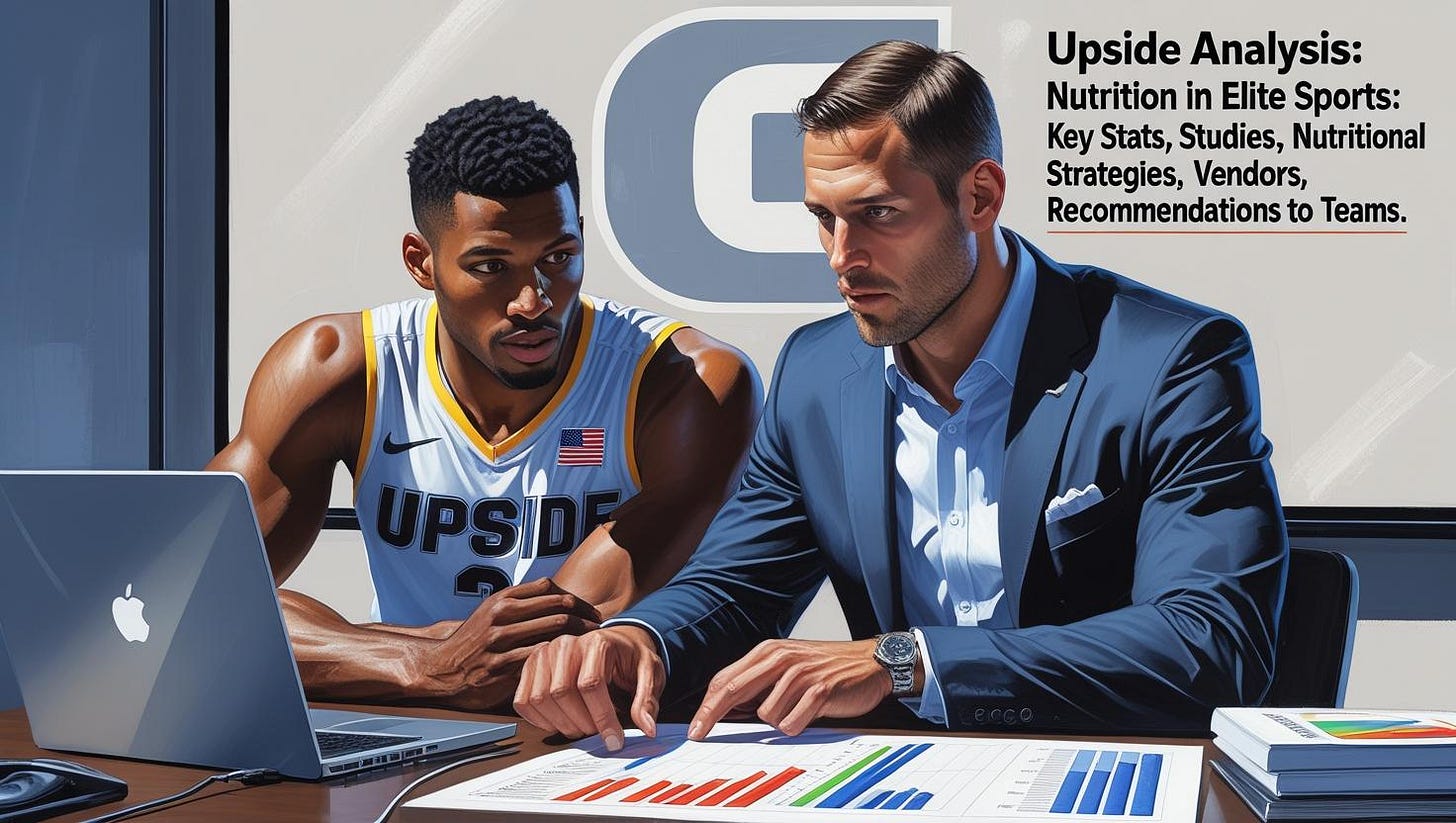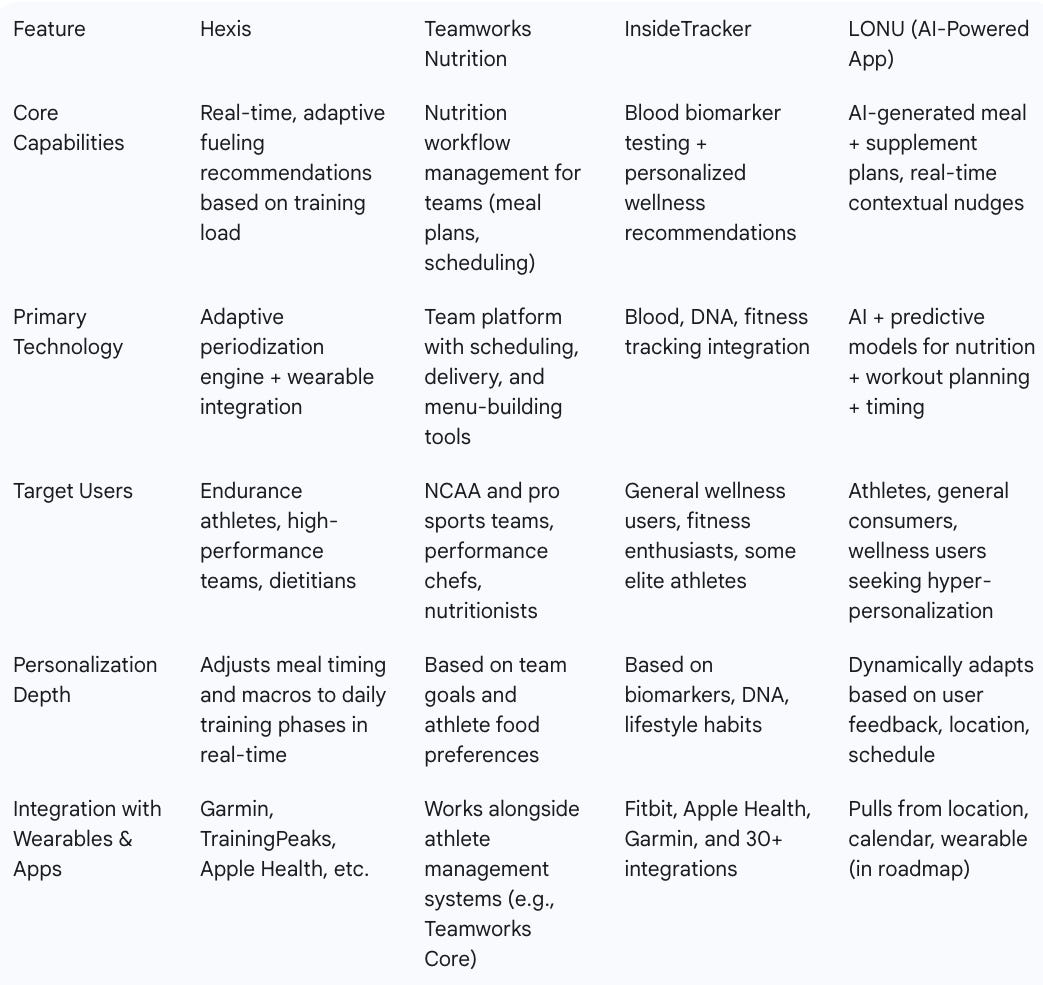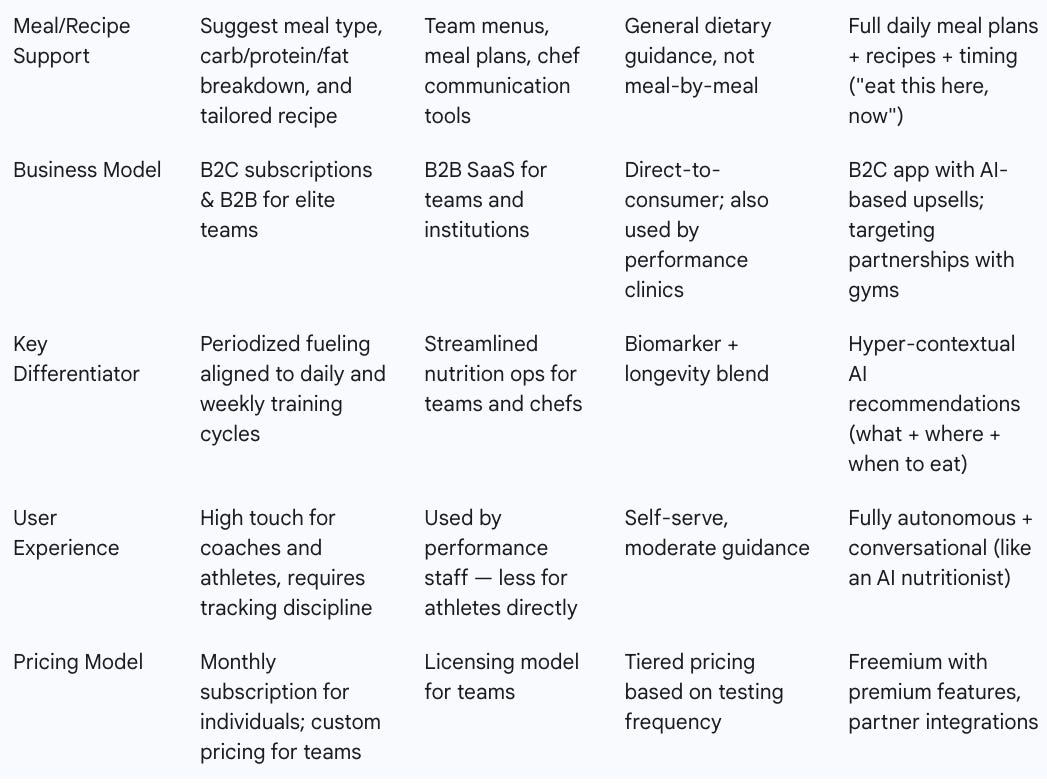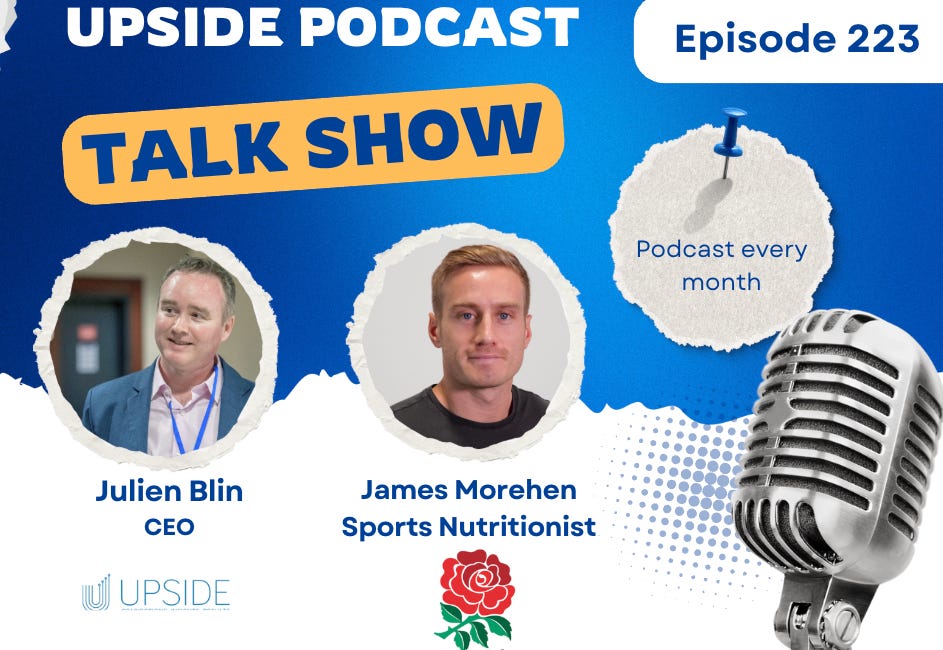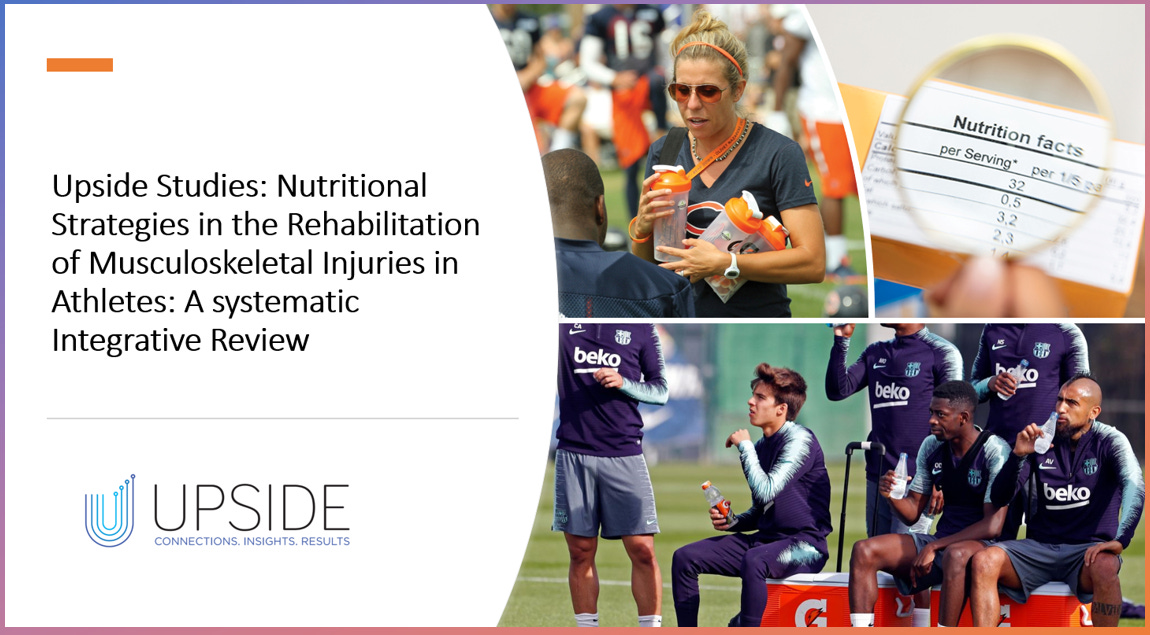🍴 Upside Analysis: Nutrition in Elite Sports: Key Stats, Studies, Nutritional Strategies, Case Studies, Vendors, Recommendations to Teams
In elite sports, every advantage counts—milliseconds can determine podium placements, and tiny imbalances can derail seasons. Among the most overlooked yet critical components of high performance is nutrition. More than just food, nutrition is the fuel, repair system, and hormonal modulator of the athlete’s body. Sports nutritionists today aren’t just meal planners—they’re data interpreters, behavioral scientists, and performance strategists.
As performance departments grow more interdisciplinary, sports nutrition is now integrated with wearable technologies, recovery analytics, and even personalized genomic data. The role of nutrition in performance, injury prevention, and recovery is finally being recognized as central to competitive success.
Why Eating Healthy Matters for Performance and Recovery
Nutrition is not just about calories in and out—it is a science of precision. For elite athletes, eating correctly at the right time affects:
Energy metabolism during high-intensity efforts
Muscle repair and hypertrophy during recovery
Hormonal regulation, impacting sleep, mood, and readiness
Inflammation management, critical for injury prevention
Cognitive sharpness, influencing reaction time, decision-making, and emotional resilience
The timing of nutrients is often as critical as the nutrients themselves. For instance, consuming a protein-carb blend within 30 minutes post-workout can enhance muscle protein synthesis by up to 40% compared to delaying intake by two hours.
Recommended Meal Plans and Nutritional Timing for Athletes
Pre-Training (2-3 hrs before):
Goal: Top off glycogen stores and provide sustained energy.
Example: Grilled chicken, brown rice, avocado, steamed vegetables, and a small banana.
During Training (for sessions >60 mins):
Goal: Maintain hydration and blood glucose.
Example: Electrolyte drink with 6–8% carbohydrates, simple carbs (fruit chews or gels).
Post-Training (0–30 mins):
Goal: Kickstart muscle repair and replenish glycogen.
Example: Whey protein shake with oats and berries, chocolate milk, or Greek yogurt + honey.
Evening Recovery Meal:
Goal: Rebuild and prepare for the next training session.
Example: Salmon, quinoa, roasted vegetables, olive oil, and mixed greens.
Meal plans vary by sport, position, training load, and body type. Periodization of nutrition (matching intake to intensity cycles) is increasingly used to optimize adaptation and body composition.
Common Mistakes Made by Nutritionists in Elite Sports
While the role of sports nutritionists has grown in importance, several common pitfalls persist:
Generic meal plans: Failing to tailor strategies to individual athlete physiology, training load, and recovery cycles.
Over-fixation on macronutrients: Neglecting hydration, micronutrients (e.g., iron, vitamin D), and gut health.
Undercommunication: Not coordinating closely with coaches, S&C staff, and medical teams, leading to misaligned goals.
Neglecting behavioral science: Ignoring how athletes' habits, preferences, and mental states influence compliance.
One-size-fits-all supplementation: Providing unnecessary or poorly absorbed supplements without proper testing or justification.
Correcting these mistakes requires a systems-based, athlete-centered, and interdisciplinary approach.
Case Studies: Elite Teams Implementing Nutritional Strategies
1. Team INEOS (now INEOS Grenadiers - Cycling)
This team uses real-time glucose monitoring and metabolic profiling to optimize feeding during races. Riders are given minute-by-minute carb intake plans, reducing bonking and improving late-stage performance.
2. U.S. Women’s National Soccer Team
Their performance nutrition program, led by sports nutritionist Lindsay Langford, focused on recovery meals, hydration monitoring, and supplement screening. This holistic strategy played a key role in their stamina and resilience during the 2019 World Cup.
Impact of Technologies and Key Vendors
🔬 Comparison Table: Hexis vs Teamworks Nutrition vs InsideTracker vs LONU
Source: Upside Global, July 2025
Hexis
Hexis is a personalised nutrition platform proven to enhance performance. Its proprietary Carb Coding™ technology delivers scalable, real-time, sport-specific personalised and periodised fuelling strategies trusted by World Tour Cycling, International Rugby, EPL and Olympic organisations (hexis.live)
Teamworks Nutrition(formerly Notemeal):
Used by over 60+ NCAA and pro teams to deliver individualized meal plans and analyze intake. (teamworks.com/nutrition) A module of the broader Teamworks platform, it enables performance staff to assign meals, track consumption, and educate athletes via content. It integrates with other recovery and load monitoring modules (teamworks.com/nutrition)
LONU
LONU built an AI based nutritional app which recommends custom workouts, meal plans, and more (lonu.ai)
InsideTracker
Combines blood biomarker analysis with actionable nutrition advice for pro athletes. (insidetracker.com)
These platforms help nutritionists shift from “one-size-fits-all” to dynamic, individualized fueling strategies.
Future of Nutritional Strategies in Elite Sports
The next decade will be shaped by precision nutrition, AI coaching, and integrated load-recovery platforms. We’ll see:
Wider adoption of continuous glucose monitoring (CGM) for in-game nutrition decisions.
Increased use of gut microbiome analysis to personalize food intake.
More integration between nutrition, sleep, training load, and readiness data.
Emergence of synthetic supplements and recovery-enhancing compounds.
Eventually, every athlete will have a real-time nutrition dashboard linked to their sleep, stress, hormonal, and training status.
Recommendations for Performance Teams
Invest in Nutrition Tech: Use AI platforms and biomarker tools to personalize and automate dietary guidance.
Hire Specialized Nutritionists: A generalist can’t keep up with evolving science—teams need experts in performance nutrition.
Educate Athletes Continuously: Nutrition is behavioral—use visual aids, gamification, and ongoing learning.
Track Compliance and Outcomes: Link nutrition intake to key KPIs: injury rate, readiness, recovery time.
Integrate Nutrition with Other Departments: Make sure strength coaches, physios, and sleep specialists are aligned with nutrition plans.
Conclusion
In elite sports, nutrition isn’t just a support mechanism—it’s a performance multiplier. Teams that embed personalized, evidence-based, and tech-enabled nutritional strategies see measurable improvements across injury prevention, recovery, and output. As the field advances with technologies like Hexis and LONU, nutritionists must lead the way in transforming data into action. In doing so, they won’t just fuel athletes—they’ll future-proof them.
You may also like:
🎙️ Upside Chat with David Dunne, CEO, Hexis, an Intelligence Nutrition Platform to Enhancing Athletes' Performance.
Today we have the honor of interviewing David Dunne, the CEO of Hexis, an intelligence nutrition platform to enhance performance.
🎙️ Upside Chat with James Morehen, Sports Nutritionist, England Men National Rugby Team
Today we have the honor of interviewing James Morehen, sports nutritionist from the England men national rugby team.
📈 🏈 Upside Studies: Nutritional Strategies in the Rehabilitation of Musculoskeletal Injuries in Athletes: A Systematic Integrative Review
Title: Upside Studies: Nutritional Strategies in the Rehabilitation of Musculoskeletal Injuries in Athletes: A Systematic Integrative Review

